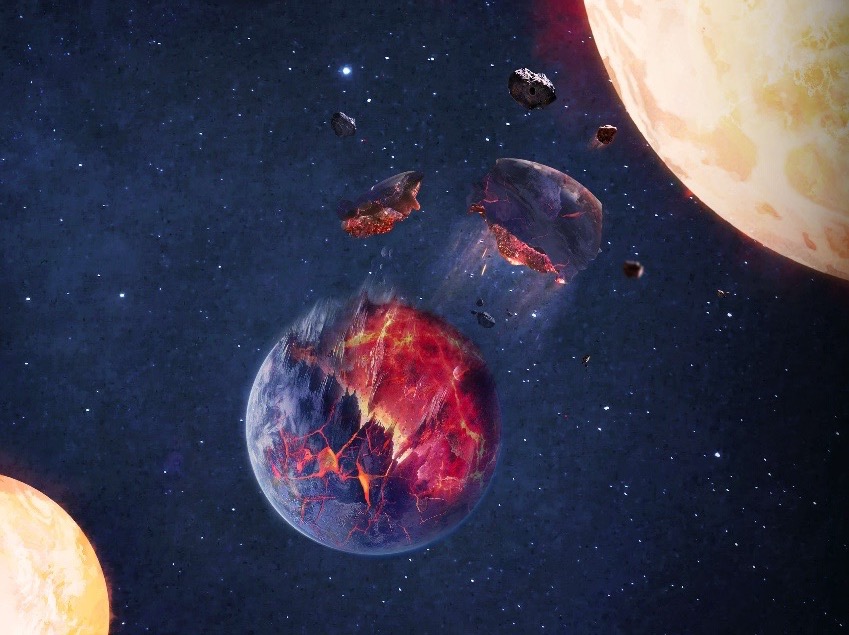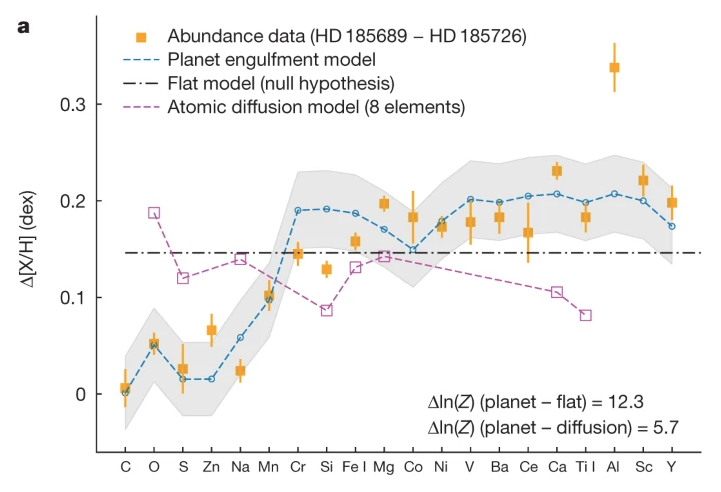A study published in Nature suggests that at least one in every dozen stars shows evidence of planet ingestion. The international research team studied twin stars that should have identical composition. But, in about eight percent of cases, they differ, perplexing astronomers.
An international team that includes Dr. Meridith Joyce, a Marie Curie Widening fellow at Konkoly Observatory of the HUN-REN Research Centre for Astronomy and Earth Sciences in Budapest, Hungary, has found that the difference is due to one of the twins devouring planets or planetary material.
The findings have been made possible thanks to a large dataset collected with the 6.5-metre Magellan Telescope and the European Southern Observatory’s Very Large Telescope, both in Chile, and the 10-meter Keck Telescope in Hawaii, United States.

A terrestrial planet being captured by a twin star. Artist’s impression by intouchable, ©OPENVERSE
“We looked at twin stars travelling together. They are born of the same molecular clouds and so should be identical,” says Dr Fan Liu, from Monash University, and lead author of the paper.
“Thanks to this very high precision analysis, we can see chemical differences between the twins. This provides very strong evidence that one of the stars has swallowed planets or planetary material and changed its composition.”
The phenomenon appeared in about eight percent of the 91 pairs of twin stars that the team looked at. What makes this study compelling is that the stars were in their prime of life, like or Sun – so-called main sequence stars, rather than stars in their final phases such as red giants.
“This is different from previous studies where late-stage stars can engulf nearby planets when the star becomes a very giant ball,” Dr. Liu says.
There is some room for doubt whether the stars are swallowing planets whole or engulfing protoplanetary material, but the authors suspect both are possible. But in either case, the chemical differences between the pairs of stars are hard to explain by any other process, such as internal processes in the stars themselves.
Internal physics and stellar evolution is Dr Joyce’s expertise: she joined Konkoly Observatory, a widely known hub for stellar astrophysics, to study and model the processes in stars that guide their lives. She says that observing twin stars have been an absolute necessity to detect signs of planet-devouring stars.
“This is essentially a “twin study:” we are making deductions about the astronomical or physical causes of differences between two stars that should be the same. The stars are “confirmed” (as best as is possible) to have had the same birth environments. This leaves only a few remaining explanations for present-day chemical differences.”, Dr. Joyce explains. “There might be some degree of statistical variation, or atomic diffusion has affected one star more than the other, but we look at atomic diffusion models, and it turns out these models also do not adequately describe differences either. The remaining hypothesis is that there was a deposit of metal- enriched material on the surface of one star and not the other---this is planet ingestion.”

Variations between abundances of chemical elements between a pair of star. Yellow dots are the measurements, the blue dashed line is the fitted planet ingestion model, the black line assumes no difference between the stars, and the purple dashed line indicates the predicted change owing to atomic diffusion (Source: Liu et al. 2024, Nature)
The findings have wide-ranging implications for the study of the long-term evolution of planetary systems. It also sheds new light on the stability of planetary systems orbiting binary star systems. In the future, researchers want to expand the sample of stars. Understanding how often stars ingest their planets can have far-reaching implications that extend even to the prevalence of life or intelligence around other stars in the Milky Way.
The study forms part of a larger collaboration, the Complete Census of Co-moving Pairs of Objects (C3PO) initiative to observe a complete sample of all bright co-moving stars identified by the Gaia astrometric satellite. Scientists from Australia’s Swinburne University of Technology, University College Cork in Ireland, Carnegie Observatories, Ohio State University, Dartmouth College in United States, Konkoly Observatory in Hungary, and the Max-Planck-Institut für Astronomie in Germany took part in the research.
Contacts:
Dr. Meridith Joyce: public.btn.email
László Molnár (HUN-REN CSFK): public.btn.email
HUN-REN CSFK communications (Adrienn Ádám): public.btn.email
The research paper can be accessed here: https://doi.org/10.1038/s41586-024-07091-y